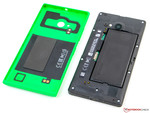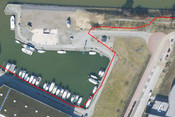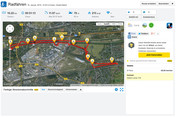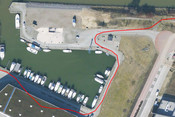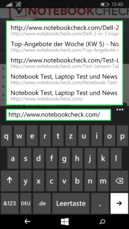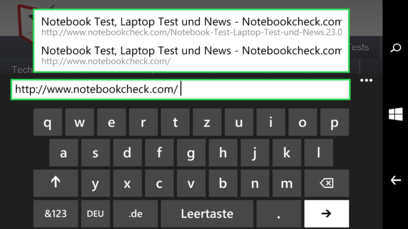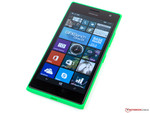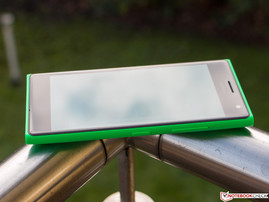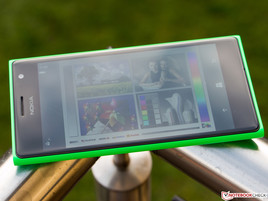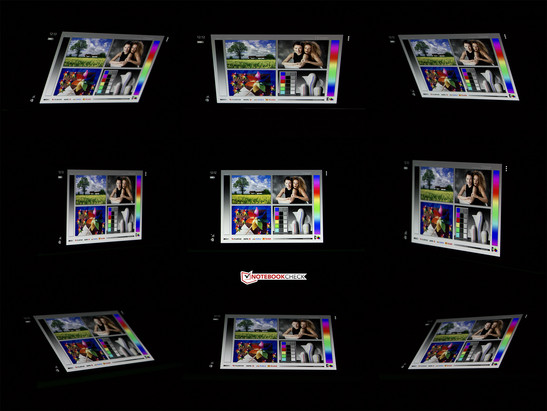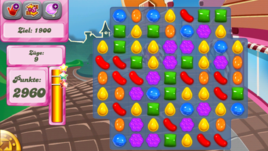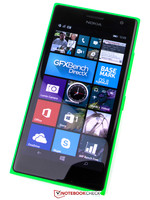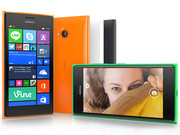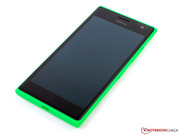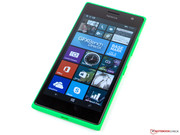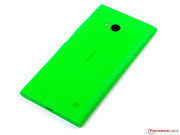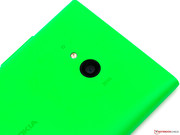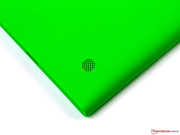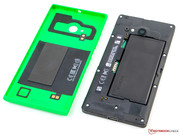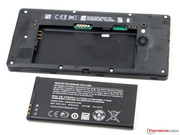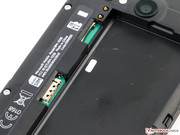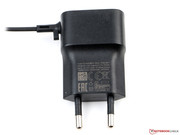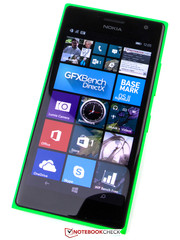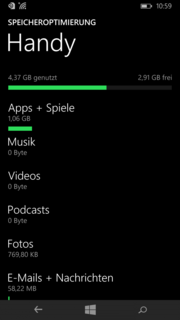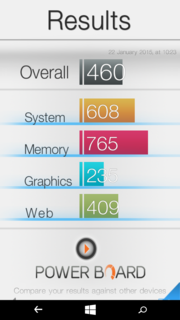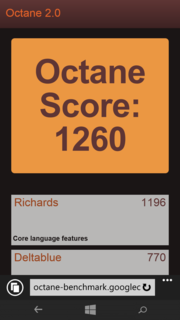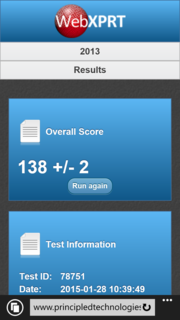Nokia Lumia 735 Smartphone Review

For the original German review, see here.
Microsoft describes their Nokia Lumia 735 - which debuted at the IFA 2014 - as a smartphones for selfies. The phone, which is equipped with a HD-AMOLED display, LTE, and a quad-core processor, appeals with both the design as well as a 5 MP front-facing camera. The 8 GB of flash storage can be expanded with a MicroSD card. Initially offered at an MSRP of 299 Euro (~$340), the price has dropped since and the phone now sells for around 250 Euro (~$285). The Lumia 730 with dual SIM card slots but without LTE retails for about 50 Euro (~$57) less.
Despite the slightly higher price tag, the Lumia 735 competes with the Motorola Moto G (200 Euro / ~$230), the HTC Desire 610 (200 Euro / ~$230), Wiko Highway (285 Euro / ~$335), and the Asus Zenfone 5 (270 Euro / $310).
Case
The Nokia Lumia 735 looks a lot like the Lumia 920, although it appears slimmer visually. The case is made entirely from colored polycarbonate and the phone is available in green, orange, white, and black.
Construction is solid and neither pressure nor torsional forces have much of an impact. We did notice some very minor friction noises during our twisting attempts, but hearing them requires a very keen ear. Because of the rounded corners, the Lumia 735 is easy to hold and it's pretty resistant to finger prints as well.
After taking off the plastic back, which is easy to remove, the user has access to the swappable battery, the MicroSD, and the Nano-SIM slot. The sibling Lumia 730 features almost identical construction, but has two SIM slots which don't support LTE.
Connectivity
The Micro-USB 2.0 port is only used to charge the smartphone and to transfer data, as neither MHL (for transferring video and audio) nor OTG (for connecting peripherals) are supported. Both DLNA and Miracast are available tough to allow the transfer of videos or for streaming purposes.
The MicroSD card slot supports up to 128 GB. Windows Phone 8.1 allows the user to install apps directly onto the SD card or to move existing apps from the internal storage after the fact.
Software
The Nokia Lumia 735 features Microsoft's own Windows Phone 8.1 (update 1) with Lumia Denim. The Lumia 830 is nearly identical in that regard, so we recommending reading that review for more information. Voice support via the personal assistant Cortana - a feature of the Lumia 535 - is not available in Europa yet, although an update is supposed to rectify that in the near future.
We didn't run into major issues during the review period. Some Windows phones with the Denim update can't play videos when using the Netflix application - our review phone was affected as well. According to Netflix (as of December 2014), Microsoft is working on a firmware update to correct the problem.
Communication & GPS
The WLAN module supports IEEE 802.11 standards b/g/n and thus can only transmit and receive using the 2.4 GHz band. The reception is good at distance and even 20 meters away from our router (Fritz!Box 6360), we still had average signal strength. Webpages load fairly quickly after an initial brief delay.
The Lumia 735 supports HSPA+ (max. 42 MBit/s) as well as LTE Cat. 4 (max. 150 MBit/s) to provide mobile data connectivity. Most European frequencies are covered, although globetrotters might discover that not all are supported.
NFC and Bluetooth 4.0 are on board as well. The latter works well without major issues, although we did notice very minor background hiss during audio transmissions.
To establish the location, the smartphone can make use of both GPS and Glonass. Satellite acquisition happens quite quickly even when the user is inside; outdoors the connectivity was more or less instantaneous.
In order to get an idea of just how accurate the GPS is, we've compared the Lumia 735 against the outdoor navigation device Garmin eTrex 30. The differences between the two is fairly minimal and during difficult conditions (like in the marina), the smartphone is actually more accurate. Overall, a very good result.
Telephone & Voice Quality
The voice transmission quality is very good. Our conversation partner had no issues understanding us no matter if we used the smartphone in conventional fashion or while using the speakerphone. We did notice, however, that we were able to understand our conversation partner better if we used the speakerphone, as the Lumia 735 sounded a bit muffled propped up against our ear.
Cameras
Microsoft calls the Lumia 735 a "Smartphone for selfies". The phone is equipped with a 5 MP (2592 x 1936 Pixel) front-facing camera with a 24 mm wide-angle lens and an aperture of f/2.4. Unfortunately, autofocus is not supported. The camera takes decent photos, although we noticed a decrease in sharpness towards the edges. The colors are vivid, but don't seem unnatural. For selfies in a social-media environment, the quality is definitely sufficient. The application Lumia Selfie allows the user to retouch the photos as he or she see fit.
The main camera has 6.7 MP and not only sports a higher resolution of 2848 x 2144 pixels, but also supports autofocus. The aperture is quite large at f/1.9 and the focal length is 26 mm. An LED flash is integrated as well. The resulting photos are noticeably sharper and look better around the edges as well. The colors are decent but could be slightly more vivid at times. Lower light results in somewhat hazy pictures and a loss of details.
Both cameras support Full-HD video (H.264, 30 fps). The main camera does particularly well here with very good-looking results. Annoying at times are the occasional push effects.
Accessories
The Nokia Lumia 735 doesn't come with a lot of accessories and only the power adapter (3.75 watts / 5 V, 0.75 A) is included in the box. The cable is integrated into the adapter, so the user needs to purchase an additional USB cable if a connection to a PC is required for data transfers. No headset is included, either.
Microsoft offers various optional accessories like external batteries, charging cradles, headphones, as well as a replacement back cover for 20 Euro (~$23).
Warranty
In Germany, Microsoft offers a 24-month warranty, which can not be extended.
Input Devices & Operation
The capacitive touchscreen is protected by Corning Gorilla Glass 3, which allows the fingers to glide easily. Inputs are recognized quickly and accurately. Should minor delays occur, they can most likely be attributed to the overall system speed.
The virtual keyboard hasn't been changed at all. In portrait mode, one-handed use is possible; users with smaller hands have to use both hands, since Microsoft doesn't offer any features to make the input easier. The available space isn't utilized very well in landscape mode and there's definitely room for improvement in that regard. The onscreen keyboards can be displayed or hidden with a simple swipe gesture. The physical buttons feature short travel and a clear click-point, but are a little stiff and thus are not that easy to depress.
Display
The 4.7-inch AMOLED display has a resolution of 1280 x 720 pixels and a corresponding ratio of 16:9 with a pixel density of 313 ppi. The resolution is sufficiently high; the display is sharp and even smaller text remains readable.
The maximum brightness of 305 cd/m² is not outstanding for a modern AMOLED display, but still quite good. The brightness distribution is very even as well. The competitors come with IPS displays, which need to be brighter since they have less contrast.
| |||||||||||||||||||||||||
Brightness Distribution: 93 %
Center on Battery: 291 cd/m²
Contrast: ∞:1 (Black: 0 cd/m²)
ΔE ColorChecker Calman: 4.04 | ∀{0.5-29.43 Ø4.78}
ΔE Greyscale Calman: 2.87 | ∀{0.09-98 Ø5}
Gamma: 2.49
CCT: 6432 K
| Nokia Lumia 735 Adreno 305, 400 MSM8926, 8 GB eMMC Flash | Motorola Moto G 2. Gen XT1068 Adreno 305, 400 MSM8226, 8 GB SSD | HTC Desire 610 Adreno 305, 400 MSM8226, 8 GB SSD | Wiko Highway Mali-450 MP4, MT6592, 16 GB iNAND Flash | Asus Zenfone 5 Adreno 305, 400 MSM8926, 8 GB eMMC Flash | |
|---|---|---|---|---|---|
| Screen | -2% | -26% | -5% | 9% | |
| Brightness middle (cd/m²) | 291 | 349 20% | 339 16% | 376 29% | 389 34% |
| Brightness (cd/m²) | 293 | 348 19% | 321 10% | 376 28% | 375 28% |
| Brightness Distribution (%) | 93 | 96 3% | 91 -2% | 88 -5% | 88 -5% |
| Black Level * (cd/m²) | 0.4 | 0.55 | 0.47 | 0.58 | |
| Colorchecker dE 2000 * | 4.04 | 3.74 7% | 5.98 -48% | 6.07 -50% | 4.22 -4% |
| Greyscale dE 2000 * | 2.87 | 4.52 -57% | 5.95 -107% | 3.6 -25% | 3.08 -7% |
| Gamma | 2.49 88% | 2.63 84% | 2.51 88% | 2.35 94% | 2.57 86% |
| CCT | 6432 101% | 7336 89% | 7398 88% | 6985 93% | 6840 95% |
| Contrast (:1) | 873 | 616 | 800 | 671 |
* ... smaller is better
Because of the AMOLED display technology, contrast and black value are absolutely outstanding. Black is as dark as it can be and the contrast ratio approaches infinite. None of the competing smartphones utilize the same technology, so they have no chance of posting similar results.
OLED screens are known to display colors too vividly and the display of the review smartphone does this as well - at least at the default settings. Some of the color deviations reach DeltaE values of 30, which is substantial. The Nokia Lumia does a good job as far as color accuracy and graylevels are concerned. The settings can be adjusted in the color profile, which leads to a much more realistic output. Users who prefer natural colors should check out our optimized settings (see screenshot), which give lead to the most satisfying experience in our opinion. The DeltaE-deviations for saturation drop to below 5 and the other results are improved as well. The panel is now very accurate and clearly outclasses the competition.
The Lumia 735 is quite usable outside. Although the contrast ratio is great and the brightness adequate, the curved glass makes it difficult to decipher the display content and more shallow angles. Normal viewing is possible without any problems. We couldn't check the special algorithm for outside use, since we didn't have sufficient sunlight and artificial light wouldn't trigger it.
Performance
The Nokia Lumia 735 is equipped with a Qualcomm Snapdragon 400 MSM8926 and 1 GB of RAM. An integrated Adreno 305 handles the graphic duties. This means that the review smartphone features the same hardware as the more expensive Lumia 830. The perceived system performance is very snappy and we encountered lag only occasionally.
The lack of benchmark titles in the Windows Store doesn't make it easy to compare the phone to others. As always, Android-equipped are a bit faster, especially when it comes to GFXBench. We should mention here though that the two operating systems use different interfaces: Windows phone uses DirectX; Android OpenGL.
Internet Explorer 11 Mobile generally does not as well as the competition when it comes to the browser benchmarks, although the browser is faster in some sub-categories. Subjectively, the phone does well and web surfing with the Lumia 735 is quick and fluent.
The Lumia smartphones are known for their fast flash storage and the 735 is no different, as a glance at Basemark OS II clearly shows. 8 GB of storage might appear to be sufficient at first, but only 2.9 GB are available to the user after the initial system start. At least it's possible to expand the storage using MicroSD cards (up to 128 GB). Since Windows Phone makes it easy to manage storage, this is definitely an added value.
| Linpack Android / IOS | |
| Single Thread (sort by value) | |
| Nokia Lumia 735 | |
| Motorola Moto G 2. Gen XT1068 | |
| Wiko Highway | |
| Asus Zenfone 5 | |
| Multi Thread (sort by value) | |
| Nokia Lumia 735 | |
| Motorola Moto G 2. Gen XT1068 | |
| Wiko Highway | |
| Asus Zenfone 5 | |
| GFXBench (DX / GLBenchmark) 2.7 | |
| 1920x1080 T-Rex Offscreen (sort by value) | |
| Nokia Lumia 735 | |
| Motorola Moto G 2. Gen XT1068 | |
| HTC Desire 610 | |
| Wiko Highway | |
| T-Rex Onscreen (sort by value) | |
| Nokia Lumia 735 | |
| Motorola Moto G 2. Gen XT1068 | |
| HTC Desire 610 | |
| Wiko Highway | |
| Sunspider - 1.0 Total Score (sort by value) | |
| Nokia Lumia 735 | |
| Motorola Moto G 2. Gen XT1068 | |
| HTC Desire 610 | |
| Wiko Highway | |
| Asus Zenfone 5 | |
| Google V8 Ver. 7 - Google V8 Ver. 7 Score (sort by value) | |
| Nokia Lumia 735 | |
| Asus Zenfone 5 | |
| Peacekeeper - --- (sort by value) | |
| Nokia Lumia 735 | |
| Motorola Moto G 2. Gen XT1068 | |
| HTC Desire 610 | |
| Wiko Highway | |
* ... smaller is better
Gaming
The Qualcomm Adreno 305 is certainly not one of the newest graphic units out there, but the performance is still adequate for all the games available in the Windows Store. When playing demanding titles like Asphalt 8 Airborne, the detail settings are automatically reduced, however. Classic games or titles which are not very demanding never push the smartphone to its limits.
The good touchscreen and the responsive sensors lead to a fun gaming experience overall.
Emissions
Temperature
The surface temperatures of the Nokia Lumia are well controlled during idle with a maximum of 26.1 °C. Under load, which we simulated with the tool Relative Benchmark, the temperature increased to 34.7 °C - barely lukewarm. Most competitors are similar in that regard and only the Wiko Highway (max. 42.3 °C) reaches a higher temperature, although there is still no reason for concern.
We ran the battery sub-test of the GFXBench 3.0 benchmark to subject the phone to a stress test. Here, the T-Rex portion runs thirty times in a row, while the frame rates and the battery life are monitored. We couldn't detect any measurable loss of performance during the test.
(+) The maximum temperature on the upper side is 34.7 °C / 94 F, compared to the average of 35.2 °C / 95 F, ranging from 21.9 to 247 °C for the class Smartphone.
(+) The bottom heats up to a maximum of 31.7 °C / 89 F, compared to the average of 34 °C / 93 F
(+) In idle usage, the average temperature for the upper side is 25.4 °C / 78 F, compared to the device average of 32.9 °C / 91 F.
Speakers
The mono speaker of the Nokia Lumia 735 is located on the back and generally produces decent sound, although we noticed a bit of distortion and occasional crackling. Mids and bass are not very strong and the sound appears somewhat muffled as a result. The sound quality is definitely sufficient for the occasional video, though. Output via the 3.5 mm jack is flawless.
Energy Management
Power Consumption
During idle, the Nokia Lumia 735 consumes between 0.6 and 1.9 watts, so the power requirement is slightly higher than that of the most powerful competitor Moto G (0.6 – 1.2 watts). We suspect that the WLAN module requires more energy. The Wiko Highway is a lot more power-hungry and needs up to 2.7 watts during idle conditions.
Under load, we recorded a power consumption of up to 3.6 watts. The power adapter is right at its limit, but can still satisfy the requirements. The Zenfone 5 (max. 3.1 watts) is the most frugal smartphone in our comparison.
| Off / Standby | |
| Idle | |
| Load |
|
Key:
min: | |
Battery Life
The battery has a capacity of 2220 mAh and the battery life is quite good. Both the maximum run time with the panel brightness turned down all the way as well as the minimum run time of 5 hours speak for themselves.
To best compare the battery life, we adjust the panel brightness to 150 cd/m² and run our WLAN-browsing test. In this test, only the Moto G (15 hours 4 minutes) lasted longer. Although the gap widened a bit when we ran the Bug Buck Bunny video test (1080p, H.264), the Lumia 735 certainly leaves us with a positive impression as far as the possible battery life is concerned.
| Nokia Lumia 735 Adreno 305, 400 MSM8926, 8 GB eMMC Flash | Motorola Moto G 2. Gen XT1068 Adreno 305, 400 MSM8226, 8 GB SSD | HTC Desire 610 Adreno 305, 400 MSM8226, 8 GB SSD | Wiko Highway Mali-450 MP4, MT6592, 16 GB iNAND Flash | Asus Zenfone 5 Adreno 305, 400 MSM8926, 8 GB eMMC Flash | |
|---|---|---|---|---|---|
| Battery runtime | 12% | -22% | -56% | -17% | |
| Reader / Idle (h) | 18.5 | 19.9 8% | 17 -8% | 18.9 2% | |
| H.264 (h) | 10.7 | 15.7 47% | |||
| WiFi (h) | 12.7 | 15.1 19% | 8.7 -31% | 6.7 -47% | 9.1 -28% |
| Load (h) | 5 | 3.7 -26% | 3.6 -28% | 1.8 -64% | 3.8 -24% |
Verdict
Microsoft's Nokia Lumia 735 is a very good middle-class smartphone. The phone is ships with an up-to-date OS, offers plenty of performance, supports LTE and features good cameras as well. Although the chassis is made from polycarbonate, the overall as well as the build quality are impressive.
The 8 GB of internal storage provide less space than expected, since less than 3 GB are actually usable. At least expansion is easy via a MicroSD card with a capacity of up to 128 GB. Speaking of expectations: the shipping box contains only the power adapter, which is stingy considering the MSRP of 299 Euro (~$340).
Despite the shortcomings, the Lumia 735 is a very well-rounded package with a good display and satisfying battery life. Although the Moto G offers superior performance in some categories, the Lumia pulls ahead in other areas.




